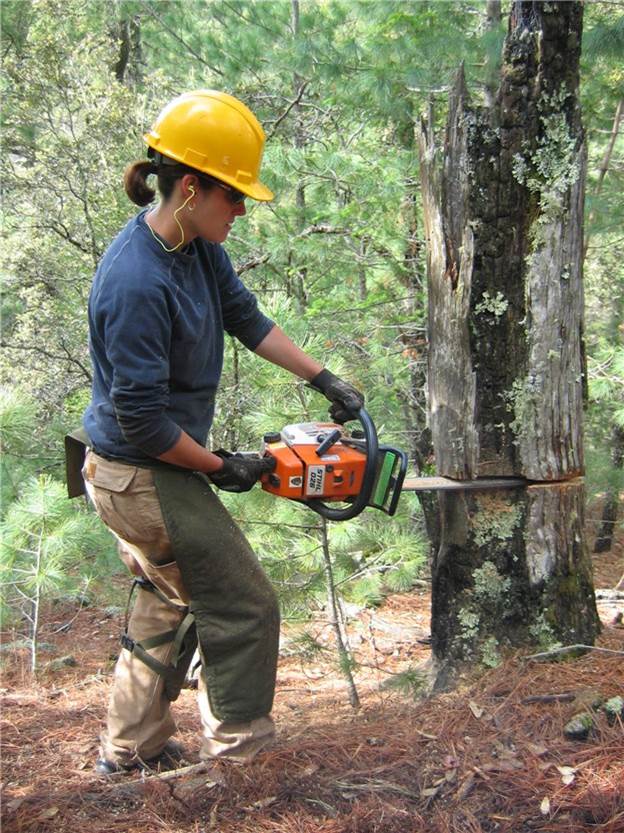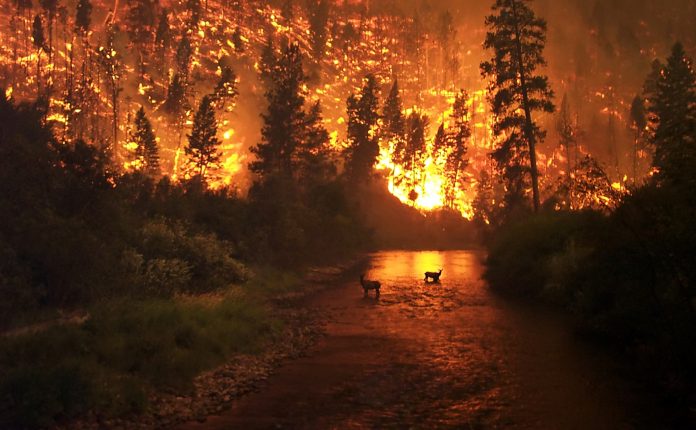Why North American cities must thin overgrown forests to improve water supplies. By Helen Poulos
As the global freshwater deficit grows, a survey of 1,000 “environmental experts” from 77 nations asked why. Was it climate change, pollution, allocation, or rising demand? Surprisingly, 79 percent said the primary culprit was deforestation
The roots of that blame are broad, deep, strong, and old. A century ago Congress founded the USFS on the national security rationale that federal protection of forest reserves would maintain the stability of the navigable rivers they fed. Over the ensuing decades, countries followed suit, assuming that reliable currents downstream always depend on dense forests upstream. The forest-water linkage now shapes widespread efforts to secure flows with large-scale afforestation of headwaters of at-risk river basins for the worthy goal of human development, resilience, climate mitigation and adaptation. Given such high stakes, it’s worth asking: does our universal mindset linking afforestation with basin health and water quantity actually, well, hold water?
The evidence points in the opposite direction. Indeed, the comfortable notion that more trees invariably result in more water, stability, livelihoods, clean air, or biodiversity has begun to look misguided at best and, at worse, catastrophic. Rather than replenish downstream runoff, aquifers, wetlands and streams, aggressive afforestation tends to dry them out and clog them up. Worldwide, many experiments indicate that rapid and aggressive afforestation and reforestation has resulted in lower water tables, less reliable springs, and reduced streamflow, especially in the dry season. Much of the global south lacks data. But in the US, the mounting body of scientific literature on the effects of land clearing on forest hydrology suggests conventional wisdom is profoundly wrong, yet tenacious in its grip.
Nowhere else are trees so highly regarded as a shade-creating panacea to pressing problems than in the US. Nowhere else honours tree planting as a sacred 150-year-old national holiday.
Nowhere else is the afforestation-secures-runoff ethic so deeply entrenched and rigidly enforced. And nowhere else have flawed assumptions proven so ecologically destructive, economically disastrous, socially disruptive, medically harmful, or politically reckless.

As California Governor, Ronald Reagan once justified clear-cut logging of old growth by asking (we assume rhetorically), “a tree is a tree; how many more do you need to look at?” Later, while running for President, he warned us how “trees cause more pollution than automobiles.” We cringed at his biases and sniggered at his willful ignorance. Yet due to forces he neither intended nor foresaw, Reagan’s “gaffes” to some extent ring true.
Why? Because today’s hottest and thirstiest parts of America are over-forested due to a vigorous and expensive federal fire-suppression initiative that has silently stocked semi-arid regions with what we estimate to be several billion trees too many.
Frequent, low-intensity fire regimes that regularly pruned back new growth have been blocked for decades on end. Now the relentless metastasising spread of native, excess trees reduces sap flow, slows wind-flow, and alters the biophysical structure of complex landscapes. Shade tolerant species take over; Aspen, lupine, sequoia, and fireweed can’t reproduce.
Less appreciated–both as crisis and opportunity–is how the afforestation caused by a century of fire suppression depletes a natural resource that has today become far more precious than toilet paper: freshwater.
More than half of humanity is now urban. Our freshwater shortfall comes from population growth, waste, pollution, rising demand for water-intensive goods–but also parasitic competition from unnatural afforestation.
Of the 39 US states facing water scarcity, few feel stress more than those west of the 98th Meridian. ‘Cities in the wilderness’–from Spokane to El Paso, Bozeman to San Diego, and Salt Lake City to Tucson–depend on forest lands where rain and snowfall filter through soil to supply water. Now, as billions of excess conifers drink up the tributaries of the Colorado, Columbia, Missouri, and Rio Grande, we’ve turned trees from friends into enemies.
The ecological blowback didn’t happen by accident, overnight. Water depletion from afforestation is the unintended consequence of our deliberate 20th century federal lands policy. For millennia, fires set by lightning or by Native Americans limited western forest stocks to roughly a few dozen trees per acre. No longer. The nationally terrifying Big Blowup wildfires of August 1910 led the US to in effect declare war on wildfire. The parallels with more recent wars on abstract nouns are eerie. The government’s tactics in both theatres include: security watchtowers, propaganda, aerial bombing and color-coded threat security alerts; ground troops carry tattered paperbacks of Sun Tzu’s The Art of War; bosses push for the deployment of drones; trained elite crews infiltrate behind enemy lines to snuff out nascent cells; Congress annually writes an emergency blank cheque, which in wildfire exceeds US$2.5 billion.
The result? More new trees compete for less sunlight, thinner soil nutrients and scarcer water availability. Insects and diseases spread faster. Unnatural afforestation creates a deadly tinderbox; fuels accumulate year after year until the inevitable wildfires burn faster, hotter, more destructively and deadly than ever, consuming the treasure of citizens and the blood of our youth–from Montana’s Mann Gulch (1949) to Colorado’s Storm King Mountain (1994) to Arizona’s Yarnell Hill (2013).
Ironically, Congress enacted the anti-fire 1911 Weeks Act and 1924 Clarke-McNary Act to save money and lives and to secure downstream navigable rivers. That era’s national security precaution reflects Eastern mentality. It backfired in the semiarid west, where fire exclusion degraded the integrity and runoff of high-elevation watershed recharge zones. Our analysis of upland research reveals downstream casualties. Suppression of fire causes suppression of flows, until you literally can’t see the river for the trees.
Yes, the dynamics are complex. Sure, it’s dangerous to overgeneralise. The extent of hydrological impacts from fire-exclusion and afforestation will fluctuate dramatically by location, depending on forest slope, aspect, age, altitude, density, latitude, species composition and natural history. But adjusting to these variables, and taking a conservative approach, we can reveal the overarching pattern of the last century.
First, the past century of fire suppression has resulted in roughly 112 to 172 more trees per acre in high-elevation forests of the west. That’s more than a fivefold increase from the pre-settlement era.

Second, denser growth means that the thicker canopy of needles will intercept more rain and snow, returning to the sky as vapour 20 to 30 percent of the moisture that had formerly soaked into the forest floor and fed tributaries as liquid. But let’s conservatively ignore potential vapour losses from ablation. Instead, assume that the lowest average daily sap flow rate is 70 litres per tree for an open forest acre of 112 new young trees. Even then, this over-forested acre transpires an additional 2.3 acre-feet of water per year, enough to meet the needs of four families.
Third, that pattern adds up. Applying low-end estimates to the more than 7.5 million acres of Sierra Nevada conifer forests suggests the water-fire nexus causes excess daily net water loss of 58 billion litres. So each year, afforestation in the absence of fire means 17 million acre-feet of water may no longer seep in or trickle down from the Sierra to families, firms, farms or endangered fisheries.
Our estimates are on the low end. Yet they align with equally conservative assessments, based on concurrent, parallel literature reviews using different methodology. Some report that “a 40 percent reduction of forested watersheds on the West slope of the Sierra Nevada could increase water runoff yields by 9 percent. More sustained and extensive treatments in these increasingly dense forests could increase water yield by up to 16 percent.” They also accord with studies of overseas semi-arid landscapes that increase yield through forest thinning.
Encouragingly, the USFS appears prepared to consider replacing our old, flawed, afforestation-boosts-streamflow mindset with the recognition that forests now and always have consumed water, and that growing threats from fire to insect outbreaks are linked to the water stress of over-forestation.
So how do we reverse all this? A century’s accumulation of dry fuel in public lands makes it too costly and risky–for people, property, habitats or emissions–to unleash prescribed fires throughout our 16-million-acre conifer tinderbox. The whine of chainsaws may generate suspicion on the left, while conservatives may object to billion-dollar public works projects. Yet a third way could aid both anemic economies and anemic rivers: surgically remove the bulk of small-diameter ‘trash trees’ through careful, transparent, contractual thinning.
Who pays? Now that a lumber mill’s trash has become a water user’s treasure, parched downstream interests could organise to restrict thinning to scrawny excess trees simply for the purpose of releasing the liquid assets they consume. Cameras can monitor every cut. Water rights markets value an acre-foot at US$450 to US$650 and up. So rather than compete with forests for rain and snow, private and public institutions could invest US$1,000 per acre to cut down fire-prone trash trees, yielding at least US$1,100 to US$1,500 worth of vital water.
This contractual approach–anchored by Western cities–pays for itself while reducing fire risk, increasing water runoff to streams and rivers, raising revenues, and boosting job growth in poor regions. What’s not to like?
There is no need for Federal or State funds or new laws. State and federal regulators should cut the red tape that might hold up local agreements between cities and rural areas that could restore forest health and replenish shrunken rivers. Regional precedents in the forest-to-faucet agreements have emerged from Denver to Raleigh.
Our cultural mindset may presume that if a dozen trees are good, 100 trees are better. But as temperatures rise, too much forest strangles too many watersheds. In order to replenish streams before they suffocate, and de-fuel the tinderbox before it explodes, we must stop hugging trees, or Smokey Bear, and embrace the images of forests with fewer trees.








